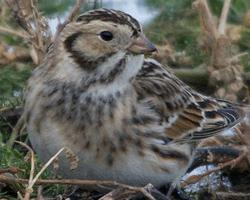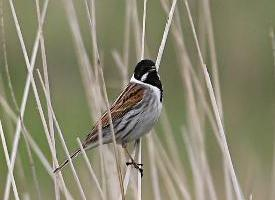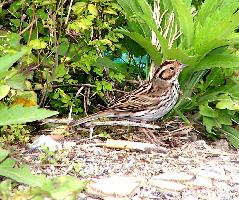
Description de l'animal
The Rustic Bunting (Emberiza rustica) is a small, yet strikingly beautiful passerine bird belonging to the bunting family, Emberizidae. Characterized by its rich, melodious song and distinctive plumage, this bird has captivated birdwatchers and nature enthusiasts alike. It is a migratory species, breeding across the taiga of northeastern Europe and Siberia, and wintering in Asia, from Japan and China to northern Southeast Asia.Adult Rustic Buntings are medium-sized birds, typically measuring between 13.5 to 15.5 centimeters in length, with a wingspan that ranges from 21 to 23.5 centimeters. Males and females exhibit some differences in their plumage, especially during the breeding season. Males boast a striking appearance with their black heads adorned with white stripes above and below the eyes, creating a distinctive facial pattern. Their upperparts are a combination of brown and black, with the brown being more prominent on the wings and back, creating a beautifully mottled effect. The breast and underparts are a soft pinkish-buff, transitioning to white on the belly. In contrast, females and non-breeding males are more subdued in color, featuring browner heads with less distinct facial patterns, and overall, their plumage is more uniformly brown and less vibrant.
One of the most remarkable aspects of the Rustic Bunting is its song. The male's singing is a delightful melody, consisting of a series of clear, sweet notes that are often delivered from a prominent perch within its breeding territory. This vocal display plays a crucial role in attracting a mate and asserting territorial claims.
The breeding habitat of the Rustic Bunting is primarily in dense taiga forests, where these birds prefer areas with a mixture of trees and shrubs, often near water bodies like rivers or wetlands. Their nests are constructed close to the ground, hidden among dense vegetation, where the female lays a clutch of 4 to 6 eggs. Both parents partake in feeding the chicks, which are ready to fledge about two weeks after hatching.
Outside the breeding season, Rustic Buntings form flocks and migrate to their wintering grounds, where they can be found in a variety of habitats, including farmlands, scrublands, and forest edges. During this time, their diet primarily consists of seeds, but they also consume insects, especially during the breeding season to feed their young.
Conservation-wise, the Rustic Bunting has faced challenges due to habitat loss and degradation, both in its breeding and wintering grounds. Although not currently listed as endangered, its populations have experienced significant declines in some areas, prompting conservation efforts to ensure its habitat is preserved and to monitor its population trends closely.
In summary, the Rustic Bunting is a captivating bird species, admired for its beautiful plumage, enchanting song, and the intriguing ecological role it plays in its natural habitat. Despite facing challenges, it continues to thrive in the vast expanses of the taiga and the diverse landscapes of its wintering grounds, a testament to the resilience of nature.
Animaux similaires
Nouvelles photos d'animaux
Top 10 des animaux
- Dolphin gull (Leucophaeus scoresbii)
- Diana monkey (Cercopithecus diana)
- Moustached guenon (Cercopithecus cephus)
- Galápagos tortoise (Geochelone nigra complex)
- Stone loach (Barbatula barbatula)
- Japanese macaque (Macaca fuscata)
- Russian tortoise (Testudo horsfieldii)
- Greek tortoise (Testudo graeca)
- Common flying dragon (Draco volans)
- Vendace (Coregonus albula)


